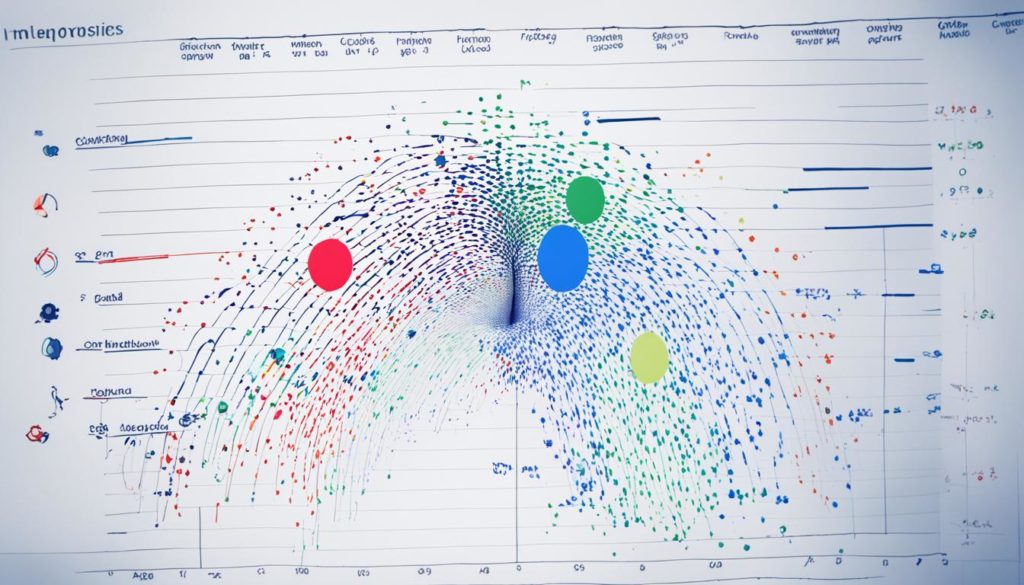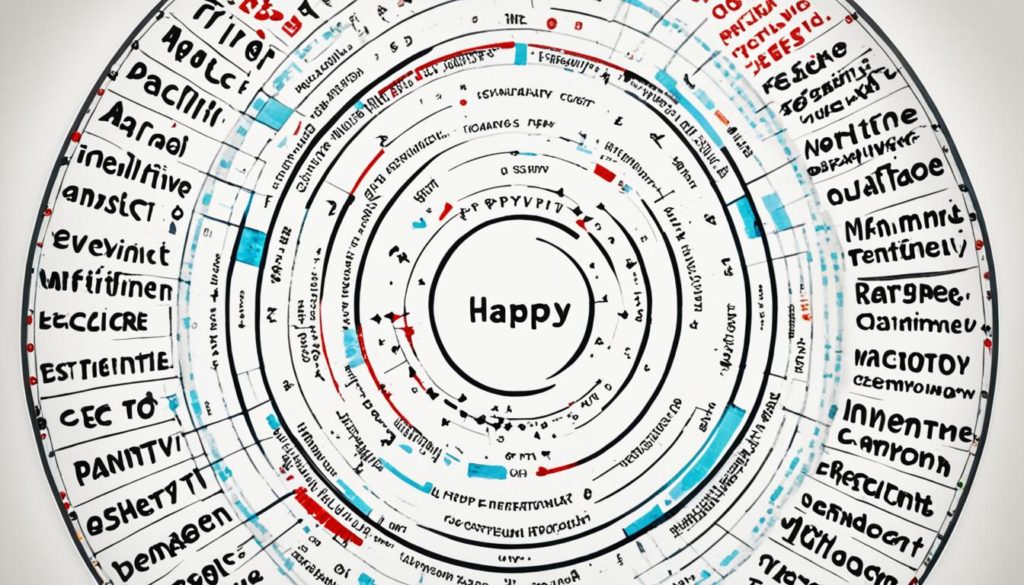
Every day, almost half a billion tweets hit the web, sharing emotional stories. Python sentiment analysis dives into this sea of tweets. It helps us understand whether content is happy, sad, or neutral. This insight is key for making smart choices.
Python teams up with Hugging Face Transformers and tools like PyTorch and TensorFlow. Together, they excel at understanding text emotions. Tools such as Pandas and Matplotlib make Python perfect for digging into what people really mean.
We use Python to make strong sentiment analysis models. We get live Twitter data and info from sites like Kaggle to test them. RoBERTa, a type of model, turns out to be really good at this work. It’s great news for businesses and researchers looking at social media feelings.
Learn more about mastering sentiment analysis in Python with Hugging Face Transformers.
Key Takeaways
- Python is a powerful foundation for sentiment analysis projects.
- Hugging Face Transformers library offers state-of-the-art pre-trained models built on PyTorch and TensorFlow.
- Essential libraries for data-related tasks include Pandas, NumPy, Matplotlib, Seaborn, and Transformers.
- Data collection strategies involve using the Twitter API and pre-labeled datasets from sources like Kaggle.
- RoBERTa model stands out with superior accuracy after fine-tuning for sentiment analysis.
- The web application enhances user accessibility for real-time sentiment predictions.
- Sentiment analysis provides invaluable insights for data scientists, researchers, and businesses.
Introduction to Sentiment Analysis
Sentiment analysis, or opinion mining, is key for both businesses and researchers. It lets us catch the mood behind written words. This is crucial for understanding what the public thinks and making smart choices. It’s time to explore why it’s so important and how it’s used.
What is Sentiment Analysis?
In a nutshell, sentiment analysis figures out if texts are positive, negative, or neutral. We use tools like Text Blob and VADER to do this with Python. The process includes breaking down the text, finding key features, assigning a sentiment, and checking our work. It’s how we figure out the emotions in everything from tweets to reviews.
Importance in Today’s Digital Age
Today, knowing what people think is more important than ever. Keeping an eye on how people feel, especially on sites like Twitter, helps businesses spot trends and feelings. Such real-time tracking lets companies make quick, effective plans, fix issues fast, and look good to the public.
Applications of Sentiment Analysis
This analysis is useful in many areas. Companies use it for watching social media, understanding customer feedback, and even guessing stock prices. Big names like Facebook and Instagram use it to make their apps better by feeling out what users like or dislike. And, with the help of scores from tools like Text Blob, businesses can tweak their prices and services based on solid data.
Here’s a look at the different levels of analysis:
| Type | Description |
|---|---|
| Document-level | Analyzes the sentiment of an entire document |
| Sentence-level | Evaluates sentiment in individual sentences |
| Aspect-based | Assesses sentiments toward specific aspects |
| Entity-level | Focuses on sentiments related to specific entities |
| Comparative | Compares sentiments across different entities or periods |
Thanks to Python and advanced tools like Text Blob and VADER, we can look at what people think like never before.
Getting Started with Python for Sentiment Analysis
Starting sentiment analysis with Python is thrilling. It’s praised for its power in working with text data. We’ll see why Python is great and how to get our tools ready for analyzing text.
Why Use Python?
Python leads in sentiment analysis because it offers many tools and is easy to read. This makes it good for both new and experienced programmers. Also, Python has lots of help like guides and a big community. This makes it perfect for working with text.
Essential Python Libraries
Key libraries for working with text and feelings are:
- pandas: Great for dealing with data smoothly, especially big datasets.
- NumPy: It does math for machine learning, which is vital.
- Matplotlib and Seaborn: They turn data into charts, making it easier to understand and share.
Setting Up Your Python Environment
Making Python ready for sentiment analysis needs some steps:
- First, get must-have libraries like pandas, NumPy, and others.
- Then, add deep learning tools like TensorFlow or PyTorch for advanced work.
- Consider using Google Colab for powerful computing in the cloud, rather than on your computer.
Also, linking with Hugging Face lets us use ready-made models. This makes working on sentiment analysis projects smoother and better.
| Library | Purpose |
|---|---|
| pandas | Data manipulation and analysis |
| NumPy | Numerical computations |
| Matplotlib | Data visualization |
| Seaborn | Statistical data visualization |
| TensorFlow | Deep learning framework |
| PyTorch | Machine learning and deep learning framework |
Data Collection Strategies for Twitter Sentiment Analysis
Getting top-notch data is key in our Twitter Sentiment Analysis. We use lots of tweets to understand people’s feelings by connecting with Twitter API. We rely on Twitter’s data, pre-labeled sets, and smart data preprocessing to make sense of it.
Twitter API Integration
The Twitter API is our window to real-time, popular topics. It gives us access to endless tweets, keeping our analysis up-to-date with what’s happening. This real-time tackle helps our tracking models stay current and spot on.
Using Pre-labeled Datasets
Take pre-labeled sets like the Sentiment140 Dataset, for instance. It packs 1,600,000 tweets neatly into ‘good’ and ‘bad’ feelings schools. This big set’s setup, with details under target, ids, date, flag, user, and text, helps a lot. It quickens the analysis by having labeled data ready to use.
Data Preprocessing Techniques
Prepping our data for analysis is a must. We clean up our data using various methods:
- Removing stopwords like ‘a’, ‘the’, and ‘he’.
- Leaving out punctuation marks, repeat letters, and web links.
- Using stemming and lemmatization to simplify the words.
These steps get our text data in shape for good sentiment mining. By cleaning and fixing the data, we better the measure of feelings in our models.
| Parameter | Details |
|---|---|
| Dataset Length | 1048576 |
| Shape of Data | (1048576, 6) |
| Unique Target Values | 2 |
| Columns in the Data | 6 |
| Rows in the Data | 1048576 |
Building a Sentiment Analysis Model
Start by picking the best machine learning models for sentiment analysis. The right algorithm makes sure our model can understand language well. Big libraries like Hugging Face Transformers have popular models for this, like DistilBERT and RoBERTa.
Choosing the Right Model
It’s key to pick the right machine learning models for accurate sentiment classification. DistilBERT and RoBERTa are praised for handling complex language. They start with a lot of general data and can be trained for specific jobs, making them great for certain needs.
Training and Fine-Tuning Models
Training and fine-tuning are big steps in making our model work well. At first, these models learn from a wide range of language examples. Then, we train them on specific data, such as tweets, to understand unique writing styles and improve how they measure sentiment.
Evaluating Model Performance
It’s critical to check how our model is doing with different tests. We look at things like accuracy and how well it performs on different tasks. RoBERTa often does well here, thanks to its top-notch training which makes it better at measuring sentiment accurately.
For more on training and fine-tuning these models, look at detailed guides here.
Leveraging Hugging Face Transformers
In the fast-growing world of sentiment analysis, Hugging Face Transformers are key. They help anyone wanting to use advanced natural language tools. Thanks to these pre-trained models, developers don’t have to start from zero. This makes digging into emotions efficient and really good at what it does.
Introduction to Hugging Face
Hugging Face quickly became important in the machine learning scene. It’s known for many pre-trained models it offers. These models are perfect for things like figuring out how people feel in texts. Their transformers library, made on PyTorch and TensorFlow, makes working with language easier.
Using Pre-trained Models
What’s great about Hugging Face Transformers are the ready-to-use models. Take BERT, RoBERTa, or DistilBERT for example. They know human language well. This means less time training and more time working on special projects and getting results.
Fine-Tuning with Your Dataset
Adjusting pre-trained models for your own data makes them better. Let’s say you have special texts you want to understand. Training these models a bit more helps them grasp what’s really meant in your data. This makes them not just accurate but on point for just the right jobs.
Using Hugging Face Transformers means we can quickly make sense of text data. They’re a modern must-have for understanding emotions in words.
FAQ
What is Sentiment Analysis?
Sentiment Analysis, or opinion mining, uses technology to figure out feelings from words. It sees if words are positive, negative, or neutral.
Why is sentiment analysis important in today’s digital age?
In our digital world, knowing how people feel is key. It tells us what people think about things, which helps companies and others know how to act.
What are the applications of sentiment analysis?
It’s used to watch over brands, understand what customers say, and look at social media. By reading tweets and reviews, it gives us clues to help make smart decisions.
Why should I use Python for sentiment analysis?
Python is great for this because it’s easy to use and has lots of tools. It’s used for many projects involving data and learning computers.
What are the essential Python libraries for sentiment analysis?
Pandas and NumPy help with data, while Matplotlib and Seaborn make pretty graphs. For deeper analysis, TensorFlow and PyTorch are very important.
How do I set up my Python environment for sentiment analysis?
Start by installing the tools we talked about, like pandas and TensorFlow. Or use Google Colab for an easy setup perfect for learning projects.
How can I collect data for Twitter sentiment analysis?
You can get Twitter data by using its API for real-time info or get already labeled data from sites like Kaggle. Both give you good data to work with.
What are the key data preprocessing techniques for sentiment analysis?
To get the best results, you need to clean up your data. This involves removing junk like weird characters, making words look the same, and getting rid of unnecessary words.
How do I choose the right sentiment analysis model?
For the best results with sentiment analysis, you need to pick a model carefully. Some, like those from RoBERTa at Hugging Face, can be tuned to be very accurate with the right data.
What is involved in training and fine-tuning sentiment analysis models?
Training a model means picking a ready model and adjusting it to your needs. You use your own data to teach the model, improving its understanding over time.
How do I evaluate the performance of my sentiment analysis model?
To know how well your model is doing, you can use numbers like accuracy and F1 score. These help grade your model’s skill at understanding feelings in text.
What is Hugging Face and how can it be used for sentiment analysis?
Hugging Face offers top-notch tools for understanding language. With its models for analyzing feelings, you can get high-quality results by training them with your own data.
How do I use pre-trained models from Hugging Face for sentiment analysis?
To use Hugging Face’s powerful models, you need to pick the right one, put it in your Python toolbox, and then teach it with your data. This way, you can get good results quickly.
What are the benefits of fine-tuning pre-trained models with my dataset?
By teaching a ready model with your data, you help it understand exactly what you need. This makes your analysis more precise and trustworthy.
Future App Studios is an award-winning software development & outsourcing company. Our team of experts is ready to craft the solution your company needs.










